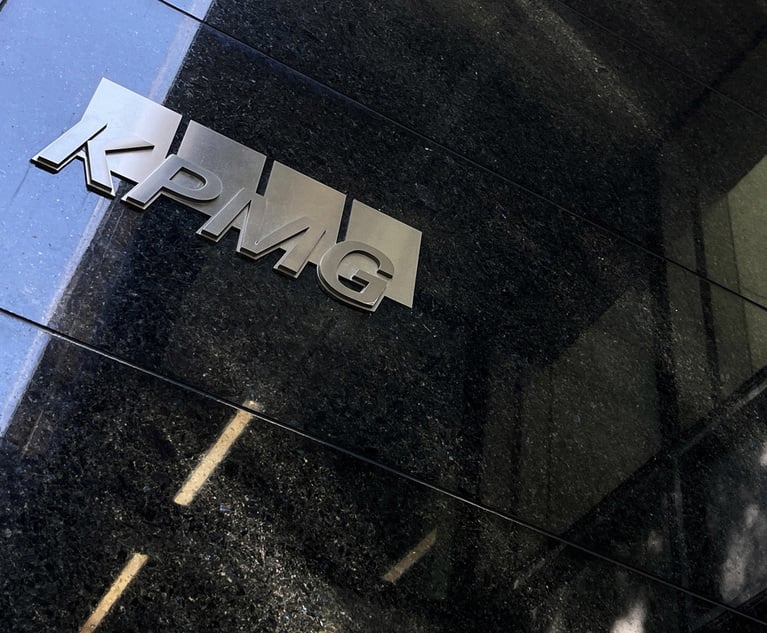The Bar Barometer
The commercial Bar is facing a difficult future, with the much-publicised downturn in litigation resulting in a tough 2006 for many chambers. Dominic Carman examines the future prospects for the leading chambers
December 06, 2006 at 07:03 PM
9 minute read
"We are heading into some form of bad weather," says Paul Cooklin, senior practice manager of 3-4 South Square, London's pre-eminent insolvency set. He is not just talking about the general economic climate, for which the ever-impressive workload of his chambers can be a useful barometer, but the specific out-look at the commercial Bar.
"Big sets will get smaller," he predicts. "The Bar will contract – not just the criminal Bar, but the commercial Bar too. There will not be enough work around. Sections of the commercial Bar will move to law firms, young barristers will decide not to go the whole course, and a number will move in-house."
Neil Palmer, senior clerk at 20 Essex Street, believes "that is very much a doomsday view – elements of which he says will be true. People who do not naturally attract work may struggle and leave".
But do Cooklin's predictions match the reality of what is happening at the largest dozen sets of chambers – those turning over more than £20m per year in fees? And what has been affecting their recent financial performance?
At Brick Court, the highest grossing commercial set in the UK, senior clerk Julian Hawes gives an overview of how things have gone in 2006. "The quality of the work is there, although the bottom has fallen out of the insurance market. Income is up and very good, but that probably reflects that we are paid six months after the event for a piece of work. Since the summer, it is much quieter than it has been for some time. The good barristers here are doing very well, but there are some at the bottom who are struggling."
Barristers struggling at Brick Court – surely that is an oxymoron?
Hawes explains: "It is not just us; speaking to others at the commercial Bar, they are saying the same thing – it is quiet."
What about his fellow members of the magic circle Essex Court Chambers, One Essex Court and Fountain Court Chambers? "It has not been an exciting year," says David Grief, senior clerk at Essex Court Chambers. "There have been a lot of settlements. Businesses are making good money and do not want to invest in litigation. I hope it is a blip and will not continue. The trouble is, we have had it good for so many years."
Paul Shrubsall, senior clerk at One Essex Court, describes 2006 as "hard work". "At the beginning of the year, it looked very good, but a lot of cases settled and nothing replaced them – that particularly affected the juniors," he says. "Things looked better for the autumn, but have gone flat again because of settlements. Cost is a deterrent for litigation – the economy is too good. We want a lot of aggressive people who want to sue everybody."
Like Robert Maxwell? "Yes, he was one of our favourite clients. If we ever had a gallery of people who had been good to chambers, he would be there."
The final member of the leading quartet, Fountain Court Chambers, plays the same downbeat tune. "Every-body feels that way at the moment," says senior clerk Mark Watson. "It has been very patchy – very quiet."
Patrick Sherrington, head of litigation at Lovells, says: "It is a fact that there are fewer smaller to medium-sized cases. That affects the bottom end of the Bar and, to some extent, the top end. But at the senior commercial Bar, the top names still seem to be quite busy – but juniors are having a much harder time."
He agrees that if it continues "there will not be the pupillages on offer or the tenancies – that is just a natural supply and demand response".
At Herbert Smith, which has its own advocacy unit spearheaded by Ian Gatt QC and Murray Rosen QC, litigation head Sonya Leydecker spells out an uncertain future for junior barristers: "We do not tend to use the junior commercial Bar very much now – we do things in-house."
She agrees that the commercial Bar will contract, but believes "the top sets will continue to grow and become more professional, making things much more difficult for some of the smaller sets".
Because there is now much more movement between chambers, the danger for small sets is that their stars will move to the bigger sets.
Ian Terry, dispute resolution partner at Freshfields Bruckhaus Deringer, adds: "There are fewer commercial cases going to trial, but there is more regulatory work and more arbitration.
"The Bar feels the fact that cases of the kind of Equitable Life and BCCI are over – they kept many barristers busy."
As the joke goes, there are 12,000 barristers, work for 8,000, and it is done by 4,000.
Martin Smith, senior clerk at Blackstone Chambers, arguably the leading challenger to the Bar's commercial elite, offers a different perspective. "Do we judge ourselves by turnover? No. When I asked my barristers if they wanted to be the highest paid at the Bar or if they wanted to be involved in the most interesting of cases, chambers voted on the latter." As a consequence, even though their turnover is close to matching that of the magic circle sets, about 15% of Black-stone's work is pro bono.
Smith offers a critique to explain the bearish mood: "Litigation is definitely slower than it has been. Mediation and alternative dispute resolution have been playing a big part. When the City is really buoyant, litigation tends to be the last resort. People prefer to settle."
The result is that aggregate revenues in the top dozen sets seem destined to plateau – in some cases they might even fall. While turnover up to mid-2006 generally increased by 5% to 10%, estimated growth for the 12 months to June 2007 varies more widely. The consensus is that it will be in the 0%-5% bracket. More bullish folk suggest 10%. A few, however, anticipate contraction of 2%-3%, possibly more.
Noteworthy in this context is the performance of two Birmingham megasets – No5 Chambers, the largest set in Britain with 180 barristers, and St Philips, the second-largest with 170 tenants. Both achieved significant double-digit growth in 2006, benefiting from increased numbers after the closure this year of Three Fountain Court in Birmingham, which saw 17 former tenants go to No5 Chambers and 23 to St Philips Chambers.
Their work and revenue streams may be dramatically different from the big London commercial sets – with crime, family and legal aid work featuring prominently – but sheer size puts both Birmingham chambers comfortably in the national top 10.
Jonathan Fox, recruited from Collyer Bristow as St Philips chief executive in January 2006, says: "We are the cheapest set of chambers to be a member of. We manage costs very tightly through group procurement. Economies of scale allow us to have a big finance and credit control team. It is run like a law firm."
Barristers benefit from an overhead as low as 6% against a more typical 10%-15% in London. Just below the magic circle by turnover, Wilberforce, Mait-land and 3 Verulam Buildings seem to have enjoyed stronger growth than their larger rivals.
"Our juniors have bucked the trend at the Bar," says Declan Redmond at Wilberforce, the leading pensions set. "We are told on a regular basis that the junior end of the Bar is going to collapse. But our young juniors in particular have had an incredible year, which has boosted income at the bottom end."
At Maitland, senior clerk Lee Clark points to a broad national and international client base as a factor in their success. "We treat the smaller provincial firms as well as we treat the City boys," says Clark. "We have to make all of them feel special." Maitland's growth is anticipated to continue at the 10% a year mark.
Smaller chambers such as 4-5 Gray's Inn Square have responded to market pressure and followed the law firms' lead by opting for streamlined, strategic practice areas – effectively sticking to what they do best. Their planning, public and financial and commercial law offerings have grown in strength this year. Former Nomura general counsel Tom O'Riordan joined chambers earlier this year.
At 3 Verulam Buildings, senior practice manager Nicholas Hill says: "Although the trend has been for litigation dropping, we have been very busy." He identifies banking, fraud and arbitration as strong areas for his set where 10% growth is also predicted for 2007.
In the July round of new silks – the first for three years – 7 King's Bench Walk topped the list of appointees with six successful applications out of six. Essex Court now heads the overall silk list with 33 QCs, five of whom were appointed this year. After failing in his protracted effort on behalf of the BCCI liquidators against the Bank of England, "things have picked up nicely for Gordon Pollock", says Grief. "He has been in court on several occasions, including the Mainstream v Young case in the Lords, and has a six-week commercial trial starting in January."
In interview, while doodling on a notepad, Pollock admits to having found the BCCI case "too long and quite boring". For a man who has turned down the High Court bench on several occasions, there must have been some consolation in the £3m brief fee and refreshers of more than £1m.
Focus on the top Bar earnings has moved away from the traditional triumvirate of Grabiner, Pollock and Sumption. Although Sumption remains as much in demand as ever, Pollock appears to be not quite as busy and Grabiner, although very active in 2006 with the Apple v Apple case, seems ready to pass his mantle to Laurence Rabinowitz QC at One Essex Court.
The new, and perhaps unlikely, Bar superstars are in tax – John Gardiner QC at 11 New Square and Graham Aaronson QC at Pump Court Tax Chambers. Both are thought to have grossed more than £3m this year. Brick Court, despite a cautious assessment from Julian Hawes, now has three or four silks alongside Sumption in the £2m-plus bracket. Tough times at the commercial Bar are, of course, relative.
This content has been archived. It is available through our partners, LexisNexis® and Bloomberg Law.
To view this content, please continue to their sites.
Not a Lexis Subscriber?
Subscribe Now
Not a Bloomberg Law Subscriber?
Subscribe Now
NOT FOR REPRINT
© 2025 ALM Global, LLC, All Rights Reserved. Request academic re-use from www.copyright.com. All other uses, submit a request to [email protected]. For more information visit Asset & Logo Licensing.
You Might Like
View All
Is KPMG’s Arizona ABS Strategy a Turning Point in U.S. Law? What London’s Experience Reveals
5 minute read
KPMG Moves to Provide Legal Services in the US—Now All Eyes Are on Its Big Four Peers

International Arbitration: Key Developments of 2024 and Emerging Trends for 2025
4 minute read
The Quiet Revolution: Private Equity’s Calculated Push Into Law Firms
5 minute readTrending Stories
- 1Family Court 2024 Roundup: Part I
- 2In-House Lawyers Are Focused on Employment and Cybersecurity Disputes, But Looking Out for Conflict Over AI
- 3A Simple 'Trial Lawyer' Goes to the Supreme Court
- 4Clifford Chance Adds Skadden Rainmaker in London
- 5Latham, Kirkland and Paul Weiss Climb UK M&A Rankings
Who Got The Work
J. Brugh Lower of Gibbons has entered an appearance for industrial equipment supplier Devco Corporation in a pending trademark infringement lawsuit. The suit, accusing the defendant of selling knock-off Graco products, was filed Dec. 18 in New Jersey District Court by Rivkin Radler on behalf of Graco Inc. and Graco Minnesota. The case, assigned to U.S. District Judge Zahid N. Quraishi, is 3:24-cv-11294, Graco Inc. et al v. Devco Corporation.
Who Got The Work
Rebecca Maller-Stein and Kent A. Yalowitz of Arnold & Porter Kaye Scholer have entered their appearances for Hanaco Venture Capital and its executives, Lior Prosor and David Frankel, in a pending securities lawsuit. The action, filed on Dec. 24 in New York Southern District Court by Zell, Aron & Co. on behalf of Goldeneye Advisors, accuses the defendants of negligently and fraudulently managing the plaintiff's $1 million investment. The case, assigned to U.S. District Judge Vernon S. Broderick, is 1:24-cv-09918, Goldeneye Advisors, LLC v. Hanaco Venture Capital, Ltd. et al.
Who Got The Work
Attorneys from A&O Shearman has stepped in as defense counsel for Toronto-Dominion Bank and other defendants in a pending securities class action. The suit, filed Dec. 11 in New York Southern District Court by Bleichmar Fonti & Auld, accuses the defendants of concealing the bank's 'pervasive' deficiencies in regards to its compliance with the Bank Secrecy Act and the quality of its anti-money laundering controls. The case, assigned to U.S. District Judge Arun Subramanian, is 1:24-cv-09445, Gonzalez v. The Toronto-Dominion Bank et al.
Who Got The Work
Crown Castle International, a Pennsylvania company providing shared communications infrastructure, has turned to Luke D. Wolf of Gordon Rees Scully Mansukhani to fend off a pending breach-of-contract lawsuit. The court action, filed Nov. 25 in Michigan Eastern District Court by Hooper Hathaway PC on behalf of The Town Residences LLC, accuses Crown Castle of failing to transfer approximately $30,000 in utility payments from T-Mobile in breach of a roof-top lease and assignment agreement. The case, assigned to U.S. District Judge Susan K. Declercq, is 2:24-cv-13131, The Town Residences LLC v. T-Mobile US, Inc. et al.
Who Got The Work
Wilfred P. Coronato and Daniel M. Schwartz of McCarter & English have stepped in as defense counsel to Electrolux Home Products Inc. in a pending product liability lawsuit. The court action, filed Nov. 26 in New York Eastern District Court by Poulos Lopiccolo PC and Nagel Rice LLP on behalf of David Stern, alleges that the defendant's refrigerators’ drawers and shelving repeatedly break and fall apart within months after purchase. The case, assigned to U.S. District Judge Joan M. Azrack, is 2:24-cv-08204, Stern v. Electrolux Home Products, Inc.
Featured Firms
Law Offices of Gary Martin Hays & Associates, P.C.
(470) 294-1674
Law Offices of Mark E. Salomone
(857) 444-6468
Smith & Hassler
(713) 739-1250








